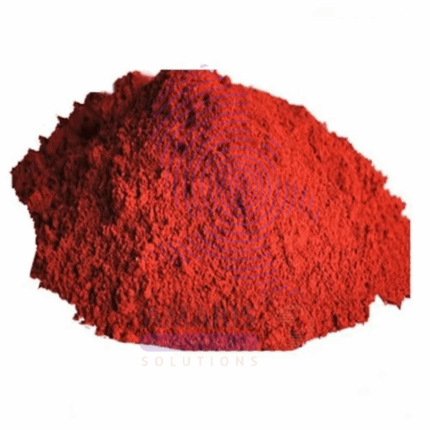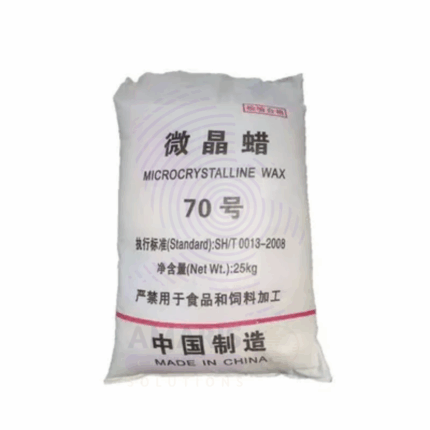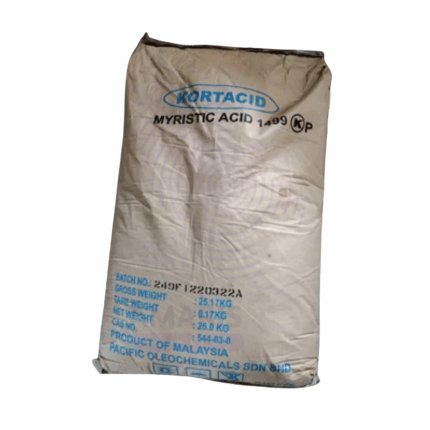Semi Refined Paraffin Wax
Semi Refined Paraffin Wax is a purified hydrocarbon wax derived from petroleum refining. It is characterized by its semi-refined nature, meaning it retains some impurities compared to fully refined waxes, but still meets industrial quality standards. This wax is solid at room temperature with a moderate melting point and is widely used in various industries due to its excellent moisture barrier properties, plasticity, and chemical inertness. It serves as a key raw material in candles, packaging, cosmetics, and coating formulations.
Primary Uses
Candle Manufacturing
Used as a base wax for producing container, pillar, and molded candles offering good burning characteristics and surface finish.
Packaging Industry
Applied as a moisture barrier coating for paper, cardboard, and food packaging to enhance water resistance and durability.
Cosmetics and Personal Care
Incorporated in formulations of lip balms, creams, lotions, and ointments for texture and emollient properties.
Rubber and Tire Industry
Used as a processing aid and release agent in rubber compounding and tire manufacturing.
Crayons and Art Supplies
Employed as a binder and base material in crayon production and other wax-based art materials.
Secondary Uses
Pharmaceuticals
Used in ointment bases and controlled-release drug formulations for its film-forming and emollient qualities.
Textile Industry
Applied as a coating agent for threads and fabrics to improve texture and water resistance.
Agriculture
Used in seed coatings and as a carrier for pesticides and fertilizers to enhance application efficiency.
Electrical Industry
Used for insulating and sealing electrical components due to its dielectric properties.
Basic Identification Attributes
Chemical Name (IUPAC): Paraffin wax (hydrocarbon mixture)
Common/Trade Name: Semi Refined Paraffin Wax
CAS Number: 8002-74-2
HS Code: 2712.90
Synonyms: Semi purified paraffin wax
Physical & Chemical Properties
Physical State: Solid wax
Color & Odor: White to off-white; mild petroleum odor
Melting Point: Typically 50–65°C (varies by grade)
Solubility: Insoluble in water; soluble in hydrocarbons and oils
Density: Approx. 0.88–0.92 g/cm³
Safety & Hazard Attributes
GHS Classification: Generally considered non-hazardous but may cause skin irritation in sensitive individuals
Toxicity: Low toxicity; avoid ingestion and prolonged skin contact
Exposure Limits: Follow workplace safety guidelines for dust and fumes
Storage & Handling Attributes
Storage Conditions: Store in a cool, dry, well-ventilated area away from sources of ignition and heat
Container Type: Supplied in blocks, slabs, or pellets packed in sealed bags or drums
Shelf Life: Stable for several years if stored properly
Handling Precautions: Use gloves and protective clothing to avoid skin contact; avoid dust inhalation
Regulatory & Compliance Attributes
Complies with industrial standards for paraffin wax products
Meets regulations for use in cosmetics and packaging where applicable
Manufactured under controlled conditions ensuring quality and safety
Environmental & Health Impact
Biodegradability: Slowly biodegradable; inert in the environment
Ecotoxicity: Low environmental toxicity; avoid release into waterways
Bioaccumulation: Not significant
PPE Required: Gloves, safety glasses, and protective clothing recommended
Handling Guidelines: Use in well-ventilated areas; avoid inhaling dust or fumes during melting
Storage Measures: Keep containers tightly closed and stored in a dry environment
First Aid Measures
Inhalation: Move to fresh air; seek medical attention if respiratory irritation occurs
Skin Contact: Wash affected area with soap and water; seek medical advice if irritation develops
Eye Contact: Rinse eyes with water for at least 15 minutes; seek medical attention if irritation persists
Ingestion: Rinse mouth; seek medical advice if large amounts are ingested
Firefighting Measures
Fire Hazards: Combustible; can release hazardous fumes when burned
Extinguishing Media: Use foam, dry chemical, CO₂, or water spray
Special Precautions: Wear protective equipment and self-contained breathing apparatus
Hazardous Combustion Products: Carbon oxides, hydrocarbons


 Preservatives(food)
Preservatives(food) Flavor Enhancers
Flavor Enhancers Acidulants
Acidulants Sweeteners
Sweeteners Antioxidants
Antioxidants Colorants(food)
Colorants(food) Nutraceutical Ingredients (food)
Nutraceutical Ingredients (food) Nutrient Supplements
Nutrient Supplements Emulsifiers
Emulsifiers
 Collectors
Collectors Dust Suppressants
Dust Suppressants Explosives and Blasting Agents
Explosives and Blasting Agents Flocculants and Coagulants
Flocculants and Coagulants Frothers
Frothers Leaching Agents
Leaching Agents pH Modifiers
pH Modifiers Precious Metal Extraction Agents
Precious Metal Extraction Agents
 Antioxidants(plastic)
Antioxidants(plastic) Colorants (Pigments, Dyes)
Colorants (Pigments, Dyes) Fillers and Reinforcements
Fillers and Reinforcements Flame Retardants
Flame Retardants Monomers
Monomers Plasticizers
Plasticizers Polymerization Initiators
Polymerization Initiators Stabilizers (UV, Heat)
Stabilizers (UV, Heat)
 Antifoaming Agents
Antifoaming Agents Chelating Agents
Chelating Agents Coagulants and Flocculants
Coagulants and Flocculants Corrosion Inhibitors
Corrosion Inhibitors Disinfectants and Biocides
Disinfectants and Biocides Oxidizing Agents
Oxidizing Agents pH Adjusters
pH Adjusters Scale Inhibitors( water)
Scale Inhibitors( water)
 Antioxidants(cosmetic)
Antioxidants(cosmetic) Emollients
Emollients Fragrances and Essential Oils
Fragrances and Essential Oils Humectants
Humectants Preservatives
Preservatives Surfactants(cosmetic)
Surfactants(cosmetic) Thickeners
Thickeners UV Filters
UV Filters
 Fertilizers
Fertilizers Soil Conditioners
Soil Conditioners Plant Growth Regulators
Plant Growth Regulators Animal Feed Additives
Animal Feed Additives Biostimulants
Biostimulants Pesticides (Herbicides, Insecticides, Fungicides)
Pesticides (Herbicides, Insecticides, Fungicides)
 Active Pharmaceutical Ingredients (APIs)
Active Pharmaceutical Ingredients (APIs) Excipients
Excipients Solvents(pharmaceutical)
Solvents(pharmaceutical) Antibiotics
Antibiotics Antiseptics and Disinfectants
Antiseptics and Disinfectants Vaccine Adjuvants
Vaccine Adjuvants Nutraceutical Ingredients (pharmaceutical)
Nutraceutical Ingredients (pharmaceutical) Analgesics & Antipyretics
Analgesics & Antipyretics
 Analytical Reagents
Analytical Reagents Solvents(lab)
Solvents(lab) Chromatography Chemicals
Chromatography Chemicals Spectroscopy Reagents
Spectroscopy Reagents microbiology-and-cell-culture-reagents
microbiology-and-cell-culture-reagents Molecular Biology Reagents
Molecular Biology Reagents Biochemical Reagents
Biochemical Reagents Inorganic and Organic Standards
Inorganic and Organic Standards Laboratory Safety Chemicals
Laboratory Safety Chemicals Specialty Laboratory Chemicals(Special Laboratory Equipment)
Specialty Laboratory Chemicals(Special Laboratory Equipment)
 Demulsifiers
Demulsifiers Hydraulic Fracturing Fluids
Hydraulic Fracturing Fluids Scale Inhibitors(oil)
Scale Inhibitors(oil) Surfactants(oil)
Surfactants(oil) Drilling Fluids
Drilling Fluids
 Dyes and Pigments
Dyes and Pigments Bleaching Agents
Bleaching Agents Softening Agents
Softening Agents Finishing Agents
Finishing Agents Antistatic Agents
Antistatic Agents
 Admixtures
Admixtures Waterproofing Agents
Waterproofing Agents Sealants and Adhesives
Sealants and Adhesives Curing Compounds
Curing Compounds Concrete Repair Chemicals
Concrete Repair Chemicals Anti-Corrosion Coatings
Anti-Corrosion Coatings
 Surfactants(cleaning)
Surfactants(cleaning) Builders
Builders Enzymes
Enzymes Solvents (Cleaning)
Solvents (Cleaning) Fragrances
Fragrances
 Electronic Chemicals
Electronic Chemicals Catalysts
Catalysts Lubricants
Lubricants Photographic Chemicals
Photographic Chemicals Refrigerants
Refrigerants Automotive chemicals
Automotive chemicals Pyrotechnic Chemicals
Pyrotechnic Chemicals
 Biodegradable Surfactants
Biodegradable Surfactants Bio-based Solvents
Bio-based Solvents Renewable Polymers
Renewable Polymers Carbon Capture Chemicals
Carbon Capture Chemicals Wastewater Treatment Chemicals
Wastewater Treatment Chemicals
 Pigments
Pigments Solvents(paint)
Solvents(paint) Specialty Coatings
Specialty Coatings Binders/Resins
Binders/Resins Additives
Additives Driers
Driers Anti-Corrosion Agents
Anti-Corrosion Agents Functional Coatings
Functional Coatings Application-Specific Coatings
Application-Specific Coatings
 Fresh Herbs
Fresh Herbs Ground Spices
Ground Spices Whole Spices
Whole Spices Spice Blends
Spice Blends Dried Herbs
Dried Herbs
 Leavening Agents
Leavening Agents Dough Conditioners
Dough Conditioners Flour Treatments
Flour Treatments Fat Replacers
Fat Replacers Decoratives
Decoratives Preservatives(baking)
Preservatives(baking)
 Plasticizers & Softeners
Plasticizers & Softeners Reinforcing Agents
Reinforcing Agents Adhesion Promoters
Adhesion Promoters Vulcanizing Agents
Vulcanizing Agents Antidegradants
Antidegradants Blowing Agents
Blowing Agents Fillers & Extenders
Fillers & Extenders Accelerators & Retarders
Accelerators & Retarders























